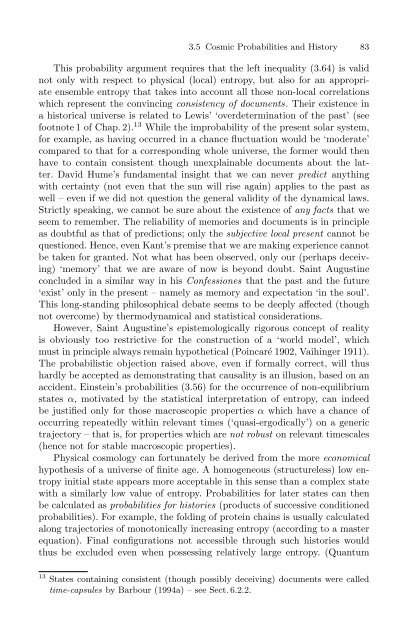The Physical Basis of The Direction of Time (The Frontiers ...
The Physical Basis of The Direction of Time (The Frontiers ...
The Physical Basis of The Direction of Time (The Frontiers ...
You also want an ePaper? Increase the reach of your titles
YUMPU automatically turns print PDFs into web optimized ePapers that Google loves.
3.5 Cosmic Probabilities and History 83<br />
This probability argument requires that the left inequality (3.64) is valid<br />
not only with respect to physical (local) entropy, but also for an appropriate<br />
ensemble entropy that takes into account all those non-local correlations<br />
which represent the convincing consistency <strong>of</strong> documents. <strong>The</strong>ir existence in<br />
a historical universe is related to Lewis’ ‘overdetermination <strong>of</strong> the past’ (see<br />
footnote 1 <strong>of</strong> Chap. 2). 13 While the improbability <strong>of</strong> the present solar system,<br />
for example, as having occurred in a chance fluctuation would be ‘moderate’<br />
compared to that for a corresponding whole universe, the former would then<br />
have to contain consistent though unexplainable documents about the latter.<br />
David Hume’s fundamental insight that we can never predict anything<br />
with certainty (not even that the sun will rise again) applies to the past as<br />
well – even if we did not question the general validity <strong>of</strong> the dynamical laws.<br />
Strictly speaking, we cannot be sure about the existence <strong>of</strong> any facts that we<br />
seem to remember. <strong>The</strong> reliability <strong>of</strong> memories and documents is in principle<br />
as doubtful as that <strong>of</strong> predictions; only the subjective local present cannot be<br />
questioned. Hence, even Kant’s premise that we are making experience cannot<br />
be taken for granted. Not what has been observed, only our (perhaps deceiving)<br />
‘memory’ that we are aware <strong>of</strong> now is beyond doubt. Saint Augustine<br />
concluded in a similar way in his Confessiones that the past and the future<br />
‘exist’ only in the present – namely as memory and expectation ‘in the soul’.<br />
This long-standing philosophical debate seems to be deeply affected (though<br />
not overcome) by thermodynamical and statistical considerations.<br />
However, Saint Augustine’s epistemologically rigorous concept <strong>of</strong> reality<br />
is obviously too restrictive for the construction <strong>of</strong> a ‘world model’, which<br />
must in principle always remain hypothetical (Poincaré 1902, Vaihinger 1911).<br />
<strong>The</strong> probabilistic objection raised above, even if formally correct, will thus<br />
hardly be accepted as demonstrating that causality is an illusion, based on an<br />
accident. Einstein’s probabilities (3.56) for the occurrence <strong>of</strong> non-equilibrium<br />
states α, motivated by the statistical interpretation <strong>of</strong> entropy, can indeed<br />
be justified only for those macroscopic properties α which have a chance <strong>of</strong><br />
occurring repeatedly within relevant times (‘quasi-ergodically’) on a generic<br />
trajectory – that is, for properties which are not robust on relevant timescales<br />
(hence not for stable macroscopic properties).<br />
<strong>Physical</strong> cosmology can fortunately be derived from the more economical<br />
hypothesis <strong>of</strong> a universe <strong>of</strong> finite age. A homogeneous (structureless) low entropy<br />
initial state appears more acceptable in this sense than a complex state<br />
with a similarly low value <strong>of</strong> entropy. Probabilities for later states can then<br />
be calculated as probabilities for histories (products <strong>of</strong> successive conditioned<br />
probabilities). For example, the folding <strong>of</strong> protein chains is usually calculated<br />
along trajectories <strong>of</strong> monotonically increasing entropy (according to a master<br />
equation). Final configurations not accessible through such histories would<br />
thus be excluded even when possessing relatively large entropy. (Quantum<br />
13 States containing consistent (though possibly deceiving) documents were called<br />
time-capsules by Barbour (1994a) – see Sect. 6.2.2.



![arXiv:1001.0993v1 [hep-ph] 6 Jan 2010](https://img.yumpu.com/51282177/1/190x245/arxiv10010993v1-hep-ph-6-jan-2010.jpg?quality=85)


![arXiv:1008.3907v2 [astro-ph.CO] 1 Nov 2011](https://img.yumpu.com/48909562/1/190x245/arxiv10083907v2-astro-phco-1-nov-2011.jpg?quality=85)








![arXiv:1002.4928v1 [gr-qc] 26 Feb 2010](https://img.yumpu.com/41209516/1/190x245/arxiv10024928v1-gr-qc-26-feb-2010.jpg?quality=85)
![arXiv:1206.2653v1 [astro-ph.CO] 12 Jun 2012](https://img.yumpu.com/39510078/1/190x245/arxiv12062653v1-astro-phco-12-jun-2012.jpg?quality=85)
